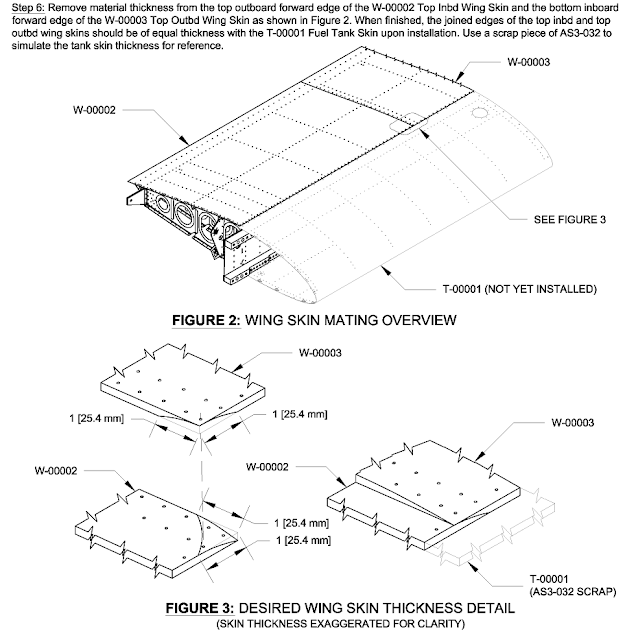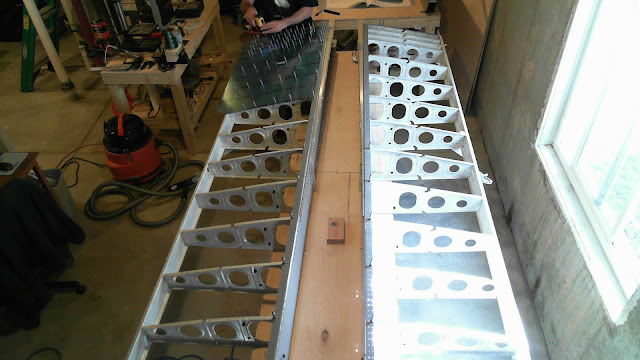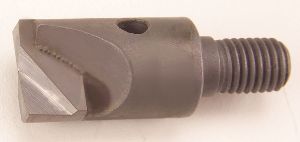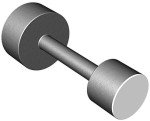The right top wing skin rivet task is maybe 50% complete with about 10 hours (!) of labor. Just 6 more ribs to go (and the fore and aft axial lines), the skin overlap seam and finally the J-channels. I've had help from four very kind individuals. It's slow going due to the need of another set of hands. Then, there's a left wing to complete!
I'm following Van's recommendation to start in the middle and work your way out. This is due to the expansion of the skin caused by each rivet. You want to push that expansion out to the edges to prevent oil-canning of the surface.
I'm following Van's recommendation to start in the middle and work your way out. This is due to the expansion of the skin caused by each rivet. You want to push that expansion out to the edges to prevent oil-canning of the surface.
I noticed that some of my wing-walk area rivets were standing a bit proud prior to setting (personally, I'm guilty of that too). I was really surprised given how much time I spent making sure the original cuts were the proper depth. I suspect it's due to 1) the primer seeping in the countersink and 2) a slightly different surface profile of the skins when finally cleco'd and riveted. Anyway, a few careful turns of the countersink cutter was necessary. Even still, most of these rivets sat less than 0.006" proud, as gleaned from the feeler gauge. Turns out that's the maximum permitted for shaving to be an option. So I buzzed them all with the shaver. Now the wing-walk is super smooth and I don't have to worry about those heads ultimately gouging through the foot traction material.
First thing to consider is how to back rivet since the rib flanges are in the way of many rivets. As noted before, the 12" double offset set is the way to go. But the collar diameter is too large, so I filed away one side to make sure it sits against the rivet fully. And the 1/8" diameter 3/4" long roll pin on my set keeps breaking. I now have a bag of 250 of these to replace as needed. Finally, the rivet set is long and not straight, so when impacted by the gun, the set absorbs quite a bit of energy in what must be compression and bending. So I run the compressor at 95 psi rather than around 60 when I use the mushroom set.
The inboard nutplates don't receive a #19 or #20 cutter for the #8 screws because the bore is tapered to provide friction against the threads. If you try to use those cutters, you can't get a deep enough cut. So you have to use a #30 cutter, very carefully. You're removing so much material that you can see the three layers of aluminum: 1) skin, 2) doubler and 3) rib flange. The delineating white stripes you're seeing below are the thin layers of primer. If you look real close, you can see the countersink isn't quite straight: It's a little deeper on the top part of the image. But a #8 screw sits in there nice and flush, and that's what matters.
The rear spar rivets around the aileron, flap and rear-fork doublers are a challenge to set. Back riveting is not an option. Careful control of a beveled, footed bucking bar is necessary. The trajectory of the shop heads on most of these rivets are a bit angled. I suspect it's not a big deal as the strength of the doublers is probably derived from the larger AN470AD4 rivets on the rear spar. In the case of the inboard fork and doubler, I'm guessing the flange there is also a lower load bearing, skin tie-down point.
I learned that removing rivets from a rib cause their dimples to crack and break. I have two rivets in the same rib that are now NAS1097AD4-3.5, so-called "oops rivets", or as I prefer Rivets of Shame. The originals had to be removed because the rivet set's roll pin broke which caused the shop heads to be horribly misshaped. With these special "oops rivets", you can't tell them from any other when viewed from the top of the skins (which is the objective), but inside it's obvious given the larger shop heads. Nice thing is, they filled up the new larger hole perfectly. Careful, on-center drilling with a #30 and deliberate deburring followed by spot priming, was necessary to clean up these two holes prior to introducing the NAS rivets.
The aileron bellcrank bracket prevents the set from being negotiated for back riveting of the top flange. Those brackets don't have to be installed in Section 14, but they're there now so the associated spar flange rivets were bucked in the classical way.
Unfortunately, during riveting between ribs 9 and 10 on the right side (the ribs between the aileron bellcrank brackets as shown above), the bucking bar wasn't held properly and dented the upper flange of the main spar. I think what happened was the bar was initially pushed into the flange prior to being seated normal to the shop head. I inspected this area very closely and can neither feel nor see any scratches or gouging. It just appears to be a compression-based dent, so it should be okay. But bummer nonetheless.
And finally, I had a heck of a time removing a rivet from rib #5 on the spar flange. I really messed it up and ended up with a nicely elongated hole. Since this mistake, I've had a lot of practice recently with removing rivets, so I'm finally skilled at it. But this specific rivet couldn't yet be the beneficiary of this new practice. You can see the disgusting hole left over from my poor technique (left image, right hole). The right image shows how poorly a standard AN426AD3-4.5 would sit. Obviously, there's a lot to fill up there.
So, this one will be replaced with a NAS1097AD4-4.5. The image below on the left shows the hole drilled out to a #30. The center image shows the NAS1097AD4-4.5 placed in the hole, nicely fitting and filling it. The right image shows the "oops" rivet set and bucked in place. Perfectly filled.










